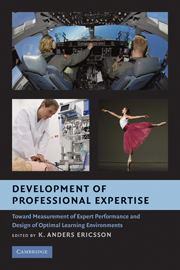 Development of Professional Expertise
Development of Professional Expertise Published online by Cambridge University Press: 04 August 2010
Within the submarine environment, sonar technicians (ST) and fire control technicians (FT) are the two largest groups of enlisted submarine specialists. The specialties, and therefore the training and performance metrics, differ in interesting ways. Sonar is largely a perceptual discrimination skill while fire control is more of a cognitive skill. The primary task of an ST is to detect and classify the signal (i.e., a sound wave) of a sonar contact; the FT's primary task is to localize (determine course, speed, and range) the sonar contact, using a set of tools, procedures, and algorithms. For both these submarine specialties, the training pipeline is changing with the addition of periodic, just-in-time, ashore classroom sessions interspersed with at-sea shipboard practice. Other significant changes include the development of more objective performance measurements that supplement the traditional qualification metrics. As a result, the STs and FTs of tomorrow should have far more systematic and comprehensive training and evaluation than even today's senior enlisted specialists.
The decision makers in the submarine environment, as everywhere, depend on sensory information that allows them to understand the state of the world. In many domains, much of that sensory information is readily available right before the eyes of the decision maker – the chess player can see the playing board and the golfer can see how the ball lies relative to the course. In contrast, there is no directly observable information about the non-static situation outside the submarine.
To save this book to your Kindle, first ensure [email protected] is added to your Approved Personal Document E-mail List under your Personal Document Settings on the Manage Your Content and Devices page of your Amazon account. Then enter the ‘name’ part of your Kindle email address below. Find out more about saving to your Kindle.
Note you can select to save to either the @free.kindle.com or @kindle.com variations. ‘@free.kindle.com’ emails are free but can only be saved to your device when it is connected to wi-fi. ‘@kindle.com’ emails can be delivered even when you are not connected to wi-fi, but note that service fees apply.
Find out more about the Kindle Personal Document Service.
To save content items to your account, please confirm that you agree to abide by our usage policies. If this is the first time you use this feature, you will be asked to authorise Cambridge Core to connect with your account. Find out more about saving content to Dropbox.
To save content items to your account, please confirm that you agree to abide by our usage policies. If this is the first time you use this feature, you will be asked to authorise Cambridge Core to connect with your account. Find out more about saving content to Google Drive.